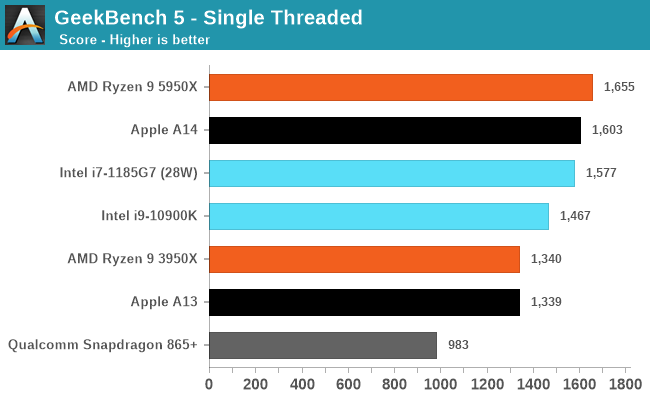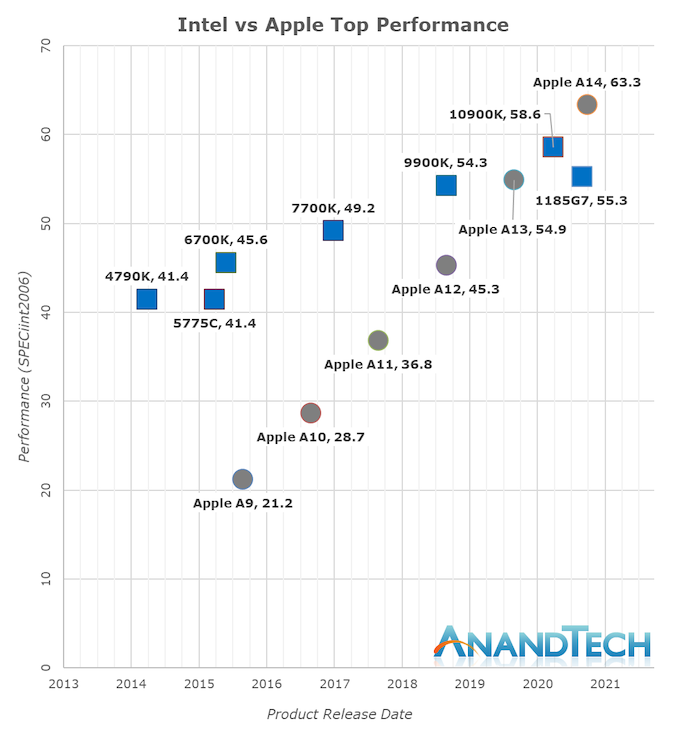Apple Announces The Apple Silicon M1: Ditching x86 - What to Expect, Based on A14
by Andrei Frumusanu on November 10, 2020 3:00 PM EST- Posted in
- Apple
- Apple A14
- Apple Silicon
- Apple M1
From Mobile to Mac: What to Expect?
To date, our performance comparisons for Apple’s chipsets have always been in the context of iPhone reviews, with the juxtaposition to x86 designs being a rather small footnote within the context of the articles. Today’s Apple Silicon launch event completely changes the narrative of what we portray in terms of performance, setting aside the typical apples vs oranges comparisons people usually argument with.
We currently do not have Apple Silicon devices and likely won’t get our hands on them for another few weeks, but we do have the A14, and expect the new Mac chips to be strongly based on the microarchitecture we’re seeing employed in the iPhone designs. Of course, we’re still comparing a phone chip versus a high-end laptop and even a high-end desktop chip, but given the performance numbers, that’s also exactly the point we’re trying to make here, setting the stage as the bare minimum of what Apple could achieve with their new Apple Silicon Mac chips.

The performance numbers of the A14 on this chart is relatively mind-boggling. If I were to release this data with the label of the A14 hidden, one would guess that the data-points came from some other x86 SKU from either AMD or Intel. The fact that the A14 currently competes with the very best top-performance designs that the x86 vendors have on the market today is just an astonishing feat.
Looking into the detailed scores, what again amazes me is the fact that the A14 not only keeps up, but actually beats both these competitors in memory-latency sensitive workloads such as 429.mcf and 471.omnetpp, even though they either have the same memory (i7-1185G7 with LPDDR4X-4266), or desktop-grade memory (5950X with DDR-3200).
Again, disregard the 456.hmmer score advantage of the A14, that’s majorly due to compiler discrepancies, subtract 33% for a more apt comparison figure.

Even in SPECfp which is even more dominated by memory heavy workloads, the A14 not only keeps up, but generally beats the Intel CPU design more often than not. AMD also wouldn’t be looking good if not for the recently released Zen3 design.

In the overall SPEC2006 chart, the A14 is performing absolutely fantastic, taking the lead in absolute performance only falling short of AMD’s recent Ryzen 5000 series.
The fact that Apple is able to achieve this in a total device power consumption of 5W including the SoC, DRAM, and regulators, versus +21W (1185G7) and 49W (5950X) package power figures, without DRAM or regulation, is absolutely mind-blowing.

There’s been a lot of criticism about more common benchmark suites such as GeekBench, but frankly I've found these concerns or arguments to be quite unfounded. The only factual differences between workloads in SPEC and workloads in GB5 is that the latter has less outlier tests which are memory-heavy, meaning it’s more of a CPU benchmark whereas SPEC has more tendency towards CPU+DRAM.
The fact that Apple does well in both workloads is evidence that they have an extremely well-balanced microarchitecture, and that Apple Silicon will be able to scale up to “desktop workloads” in terms of performance without much issue.
Where the Performance Trajectory Finally Intersects
During the release of the A7, people were pretty dismissive of the fact that Apple had called their microarchitecture a desktop-class design. People were also very dismissive of us calling the A11 and A12 reaching near desktop level performance figures a few years back, and today marks an important moment in time for the industry as Apple’s A14 now clearly is able to showcase performance that’s beyond the best that Intel can offer. It’s been a performance trajectory that’s been steadily executing and progressing for years:
Whilst in the past 5 years Intel has managed to increase their best single-thread performance by about 28%, Apple has managed to improve their designs by 198%, or 2.98x (let’s call it 3x) the performance of the Apple A9 of late 2015.
Apple’s performance trajectory and unquestioned execution over these years is what has made Apple Silicon a reality today. Anybody looking at the absurdness of that graph will realise that there simply was no other choice but for Apple to ditch Intel and x86 in favour of their own in-house microarchitecture – staying par for the course would have meant stagnation and worse consumer products.
Today’s announcements only covered Apple’s laptop-class Apple Silicon, whilst we don’t know the details at time of writing as to what Apple will be presenting, Apple’s enormous power efficiency advantage means that the new chip will be able to offer either vastly increased battery life, and/or, vastly increased performance, compared to the current Intel MacBook line-up.
Apple has claimed that they will completely transition their whole consumer line-up to Apple Silicon within two years, which is an indicator that we’ll be seeing a high-TDP many-core design to power a future Mac Pro. If the company is able to continue on their current performance trajectory, it will look extremely impressive.











644 Comments
View All Comments
name99 - Saturday, November 14, 2020 - link
Dude, I'm on *your* side...The fact that the article has one correct point doesn't mean that it's mostly garbage.
It's not a fair analysis in that it bends over backward to make x86 look good -- and still doesn't succeed.
Arsani - Saturday, November 14, 2020 - link
You know Apple is the largest PC manufacturer by revenue right. I don't even own a mac but it seems they provide the best customer experience from what I see on the internet. Apple laptops are known to come with the least defects and their customer service is the best. Another factor is their UI is aesthetically more polished than windows and their products are just more cool than the rest. Now I don't own a mac because while I might be willing to pay for their starting prices what they charge for upgrading memory and storage is just a rip off. I also don't like that I can't upgrade the parts myself. But hey it is a business and the people who just want something that works hassle-free and premium buy apple. Many people just don't have time to deal with the problems of windows like drivers, upgrading and viruses.Silver5urfer - Sunday, November 15, 2020 - link
Man what are you talking ? Least defects ? Go to Louis Rossman and learn how garbage Macbooks are. They have tons of problems, Keyboard issues, bad wiring for Display Flex cables, horrible VRM component problems, Data recovery issues due to T2 chip, no 3rd party cheaper repair options vs their overpriced garbage Genius (those people at Genius are quite opposite to that, Apple's Technical support people are bots programmed to use Apple software and then do a software based test which is supplied by Apple and 100% propreitary, no one can bypass it has activation systems and etc licensing on top, latest iPhone blocks changing of modules.)In fact all those heating related and throttling issues are the primary reason Apple is moving away from Intel x86, they could go to AMD for better compat but their market and the investors want profit not more expenditure, re tooling every single software piece of another x86 processor which also has the TDP over 50W is not suitable for Apple computers. Because their userbase don't crunch numbers on the Macs nor game on them, nor do any heavy lifting, it's made for mostly a consumption device like iPad and less of a proper workstation / desktop class machine, the OS is also heavily leaning towards Mobile centric, just look at the Big Sur OS it's another Win10 type transitional OS onto Mobile UX, but only missing part is touchscreen, Apple don't want to do it because it will kill iPad. So having a cTDP (Configurable TDP) means another VRM adjustment and on top of heavy changes to the Software / Repair / Manufacture for one more x86, that won't net the job for them when they have Millions poured into TSMC (Yeah they poured tons of cash into TSMC for R&D) and their own A-Series / ARM derivative silicon engineering.
It all boils down to the numbers and math on top of the very important factor - appeasing their customers who are non skilled in understanding computers vs the usual *nix and Windows / Gamers.
Lizardo - Wednesday, November 18, 2020 - link
Macs are garbage? Wife has a 2013 Air she won't part with, Macs got both kids through college, and I've been working at home on a Mac for 15 years without some Windows tech support guy telling me he doesn't know either. Proper maintenance and they last a long while. And Big Sur is now running on my 2013 MB Pro.Oxford Guy - Sunday, December 6, 2020 - link
"nor do any heavy lifting"Like pro video and audio?
Alistair - Saturday, November 14, 2020 - link
I bought an Intel Tiger Lake laptop today, i7-1165G7. What a piece of crap. The new Macbook is going to walk all over the PC competition. Windows notebooks looks good until you realize the fan will be running loud just browsing websites. That and the graphics performance is laughable (XE may be a big leap for Intel, but you aren't getting a solid 60fps in Overwatch at 50 percent of 1440p at low settings...).Alistair - Saturday, November 14, 2020 - link
also the screen, wow... so bad... 768p and TV in a $1000 CAD plus tax laptopmeanwhile I have to add $500 CAD to get the same CPU in the next cheapest laptop with a good screen, so the Macbook's $1300 looks better and better now I know how bad the $1000 CAD one is...
Alistair - Saturday, November 14, 2020 - link
TNtimecop1818 - Saturday, November 14, 2020 - link
You may not be getting 60fps in overwatch but at least it runs. It's not going to run on this new useless apple shittycon laptop at all.Alistair - Saturday, November 14, 2020 - link
I'm averaging 34 fps in Overwatch at 1080p LOW settings. Way worse than any review would suggest. I re-watched Dave Lee's Razer Blade laptop review with the same CPU, the score was 117 fps.https://www.bestbuy.ca/en-ca/product/hp-15-6-lapto...
Why is it so slow? I'm using the built in Xe graphics (Iris Xe) while the Razer is using external Xe add on GPU?
Better than AMD? Don't make me laugh, this is the worst $1000 laptop I've bought. Integrated AMD graphics crushes it. Apple's will be more than twice as fast easily.